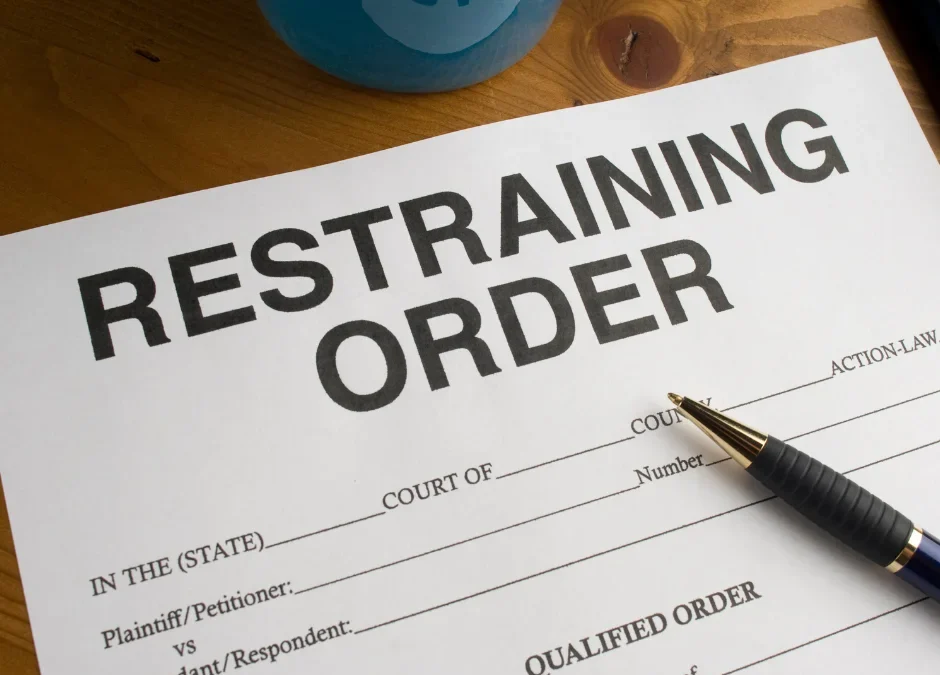Relationships are tricky; things can go sour, and you might need to opt for a restraining order in Ontario against your ex-spouse.
Before you take this step, it is crucial to arm yourself with the right knowledge to help you successfully execute your plan. If you are under serious threat, please contact women’s shelters or a family lawyer to help you with your case.
Till then, here is everything you need to know about how to file a restraining order in Ontario against your ex-spouse to do it the right way.
What is a Restraining Order?
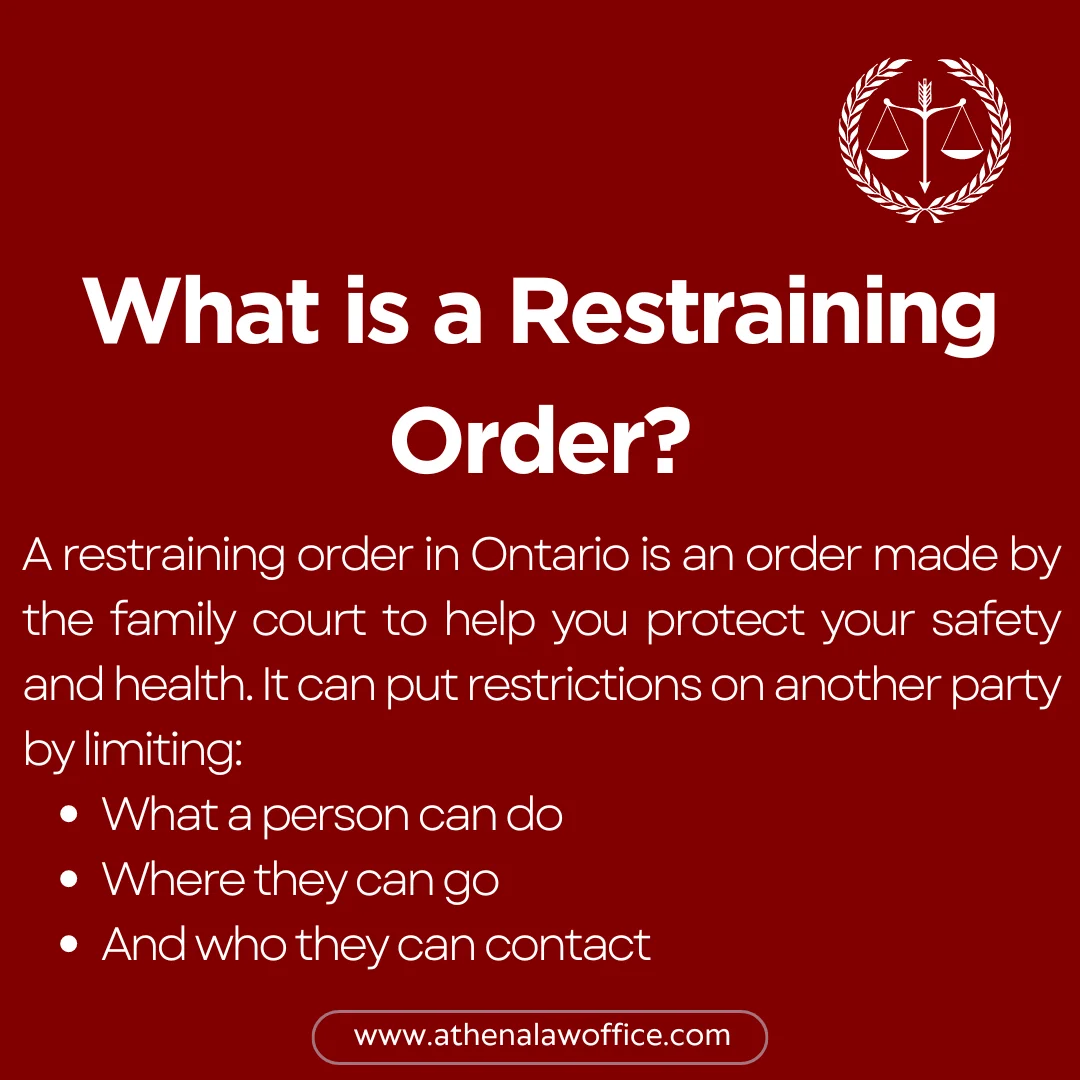
A restraining order in Ontario is an order made by the family court to help you protect your safety and health. It can put restrictions on another party by limiting:
- What a person can do
- Where they can go
- And who they can contact
Such an order can be made for your ex-spouse or children, as it can apply to them. The conditions of the restraining order will be personalized based on the specific circumstances of your case.
Can You Apply for a Restraining Order in Ontario?
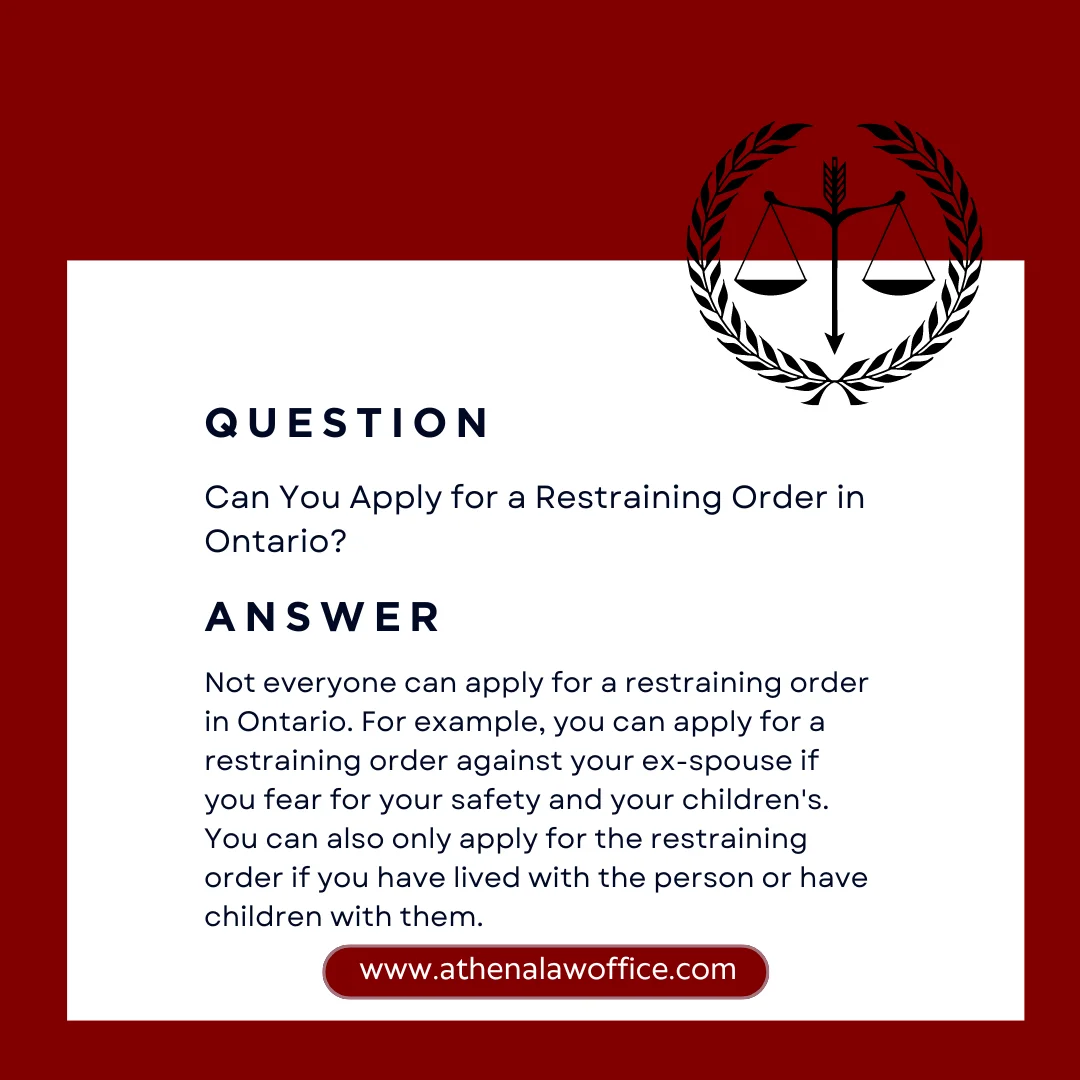
Not everyone can apply for a restraining order in Ontario. For example, you can apply for a restraining order against your ex-spouse if you fear for your safety and your children’s.
You can also only apply for the restraining order if you have lived with the person or have children with them. If you don’t meet these two conditions, then you can apply for a peace bond, which can be made against anyone, such as your neighbour.
What Does a Restraining Order in Ontario Help With?
There are many ways a restraining order in Ontario can help you. For example, the person you fear can’t communicate with you or your children in any way.
Besides that, they are also not allowed to come near a specific distance from you and the children. They are also not allowed to go to a certain distance of places you frequently visit, such as your:
- Workplace
- Family member’s home
- Home
- Children’s school
- Place of worship
- And much more
Depending on the circumstances of your case, a judge can also put other types of limitations in the restraining order. So, when you apply, you must have clarity on the type of limitations that will help you and make this clear to the judge.
Doing this will ensure that the judge understands your case, and the restraining order is enforceable and effective. If you don’t know where to start being specific, you can get in touch with our family lawyer in Ontario to help you out.
Types of Restraining Orders in Ontario
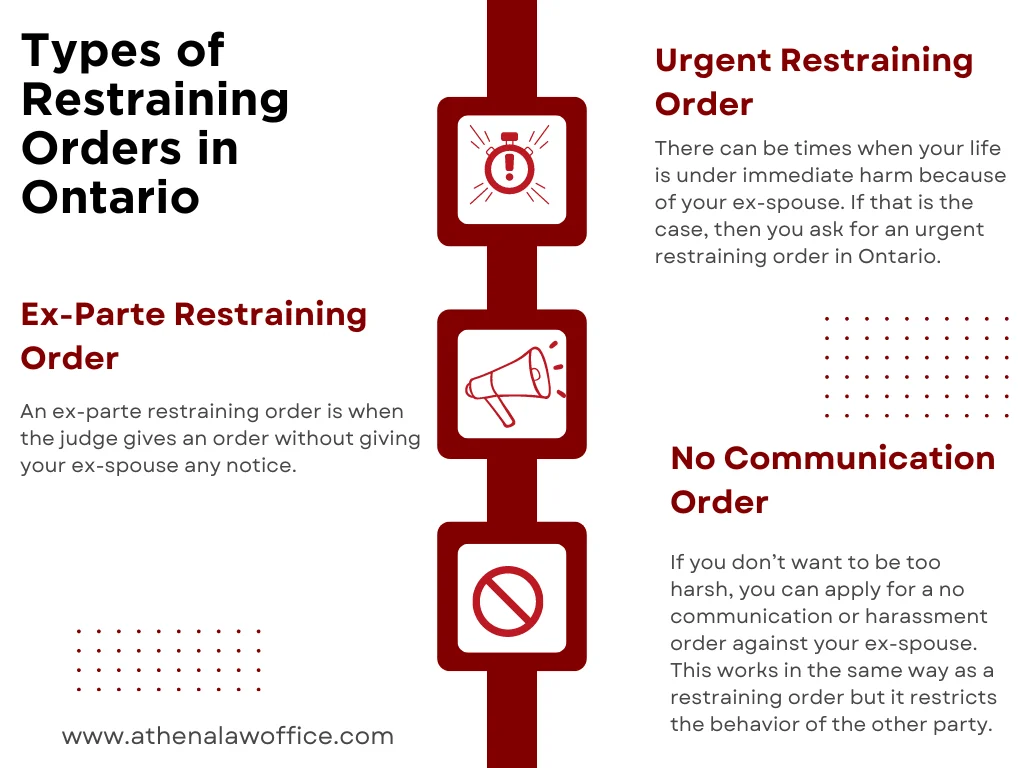
Depending on your circumstances and case, you can get a different type of restraining order in Ontario. We have discussed each one in detail to help you understand which one might be applicable to you.
1. Urgent Restraining Order
There can be times when your life is under immediate harm because of your ex-spouse. If that is the case, then you ask for an urgent restraining order in Ontario.
Before you make this type of application, we recommend you consult with our lawyer. The reason for this is that if the court doesn’t think your application is urgent, then you might have to end up paying the legal costs of the other party.
Another note to remember is that this type of restraining order will only last a while to provide you with temporary protection. Till, then you can apply for a permanent restraining order for long-term protection.
2. Ex-Parte Restraining Order
The norm of any restraining order is that your ex-spouse will receive a notice letting them know of the order. However, an ex-parte restraining order is when the judge gives an order without giving your ex-spouse any notice.
This is only a temporary solution to help you stay safe. Another situation where you can use this order is when your ex-spouse is not available to make an appearance in court.
In such a situation, the restraining order will be applicable till the other party comes to court. Then, the judge will hear both sides and make a final decision.
If you need more assistance for the restraining order and court process, you can get in touch with our family lawyer for more information.
3. No Communication/Harassment Order
If you don’t want to be too harsh, you can apply for a no-communication or harassment order against your ex-spouse. This works in the same way as a restraining order but it restricts the behavior of the other party.
For example, this order will hinder your ex-spouse from directly or indirectly communicating with you. On the other hand, if your ex-spouse breaches this order, they will not face any criminal consequences.
So, if your case is not too extreme, you can consider opting for this type of order.
How to Apply for a Restraining Order in Ontario Against an Ex-Spouse
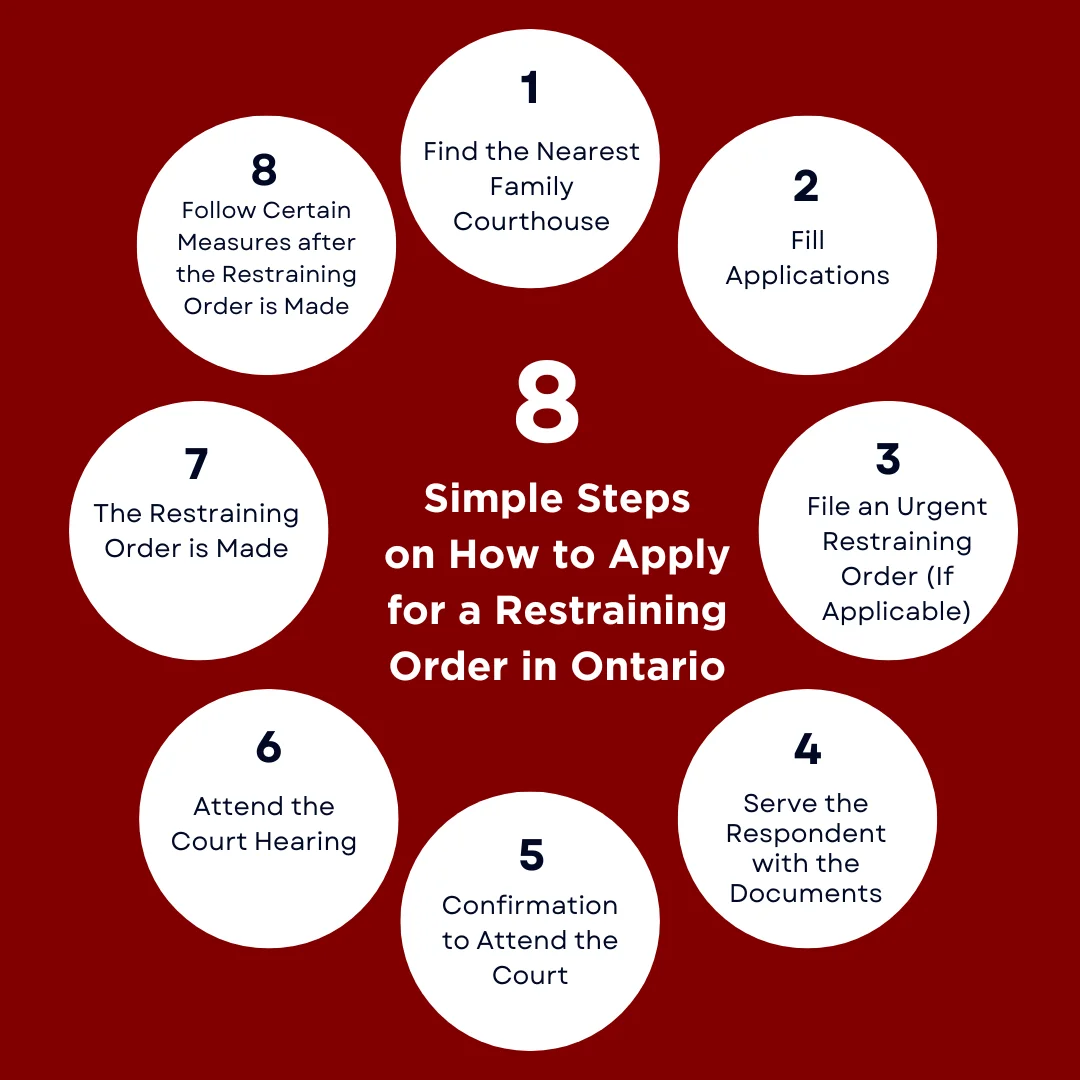
Now that you know some basics about a restraining order in Ontario, you might want to know how to apply for one. Here are all the steps you can follow to learn how to apply for a restraining order against your ex-spouse in Ontario:
1. Find the Nearest Family Courthouse
The first thing you must do is find a family courthouse close to where you live. The rule is to select the court of the municipality where you or your ex-spouse are residing.
On the other hand, if your case also involves parenting arrangements, then you can also begin the case where your children are residing. So, select what will work best for you.
2. Fill Applications
To begin the court process for any family matter it is important to file Form 8, which is a general application. If there are other family issues pertaining to your case, you can also ask for other orders in the application.
However, depending on your circumstances, you might need more supporting Ontario court forms to complete your application. On the other hand, if you want to complete the application for a restraining order, you must also complete:
- A Continuing Record, which includes a Table of Contents
- The Canadian Police Information Centre Restraining Order Information Form. You will only find this at the counter of the family court.
Be sure to collect proof such as police reports, photographs of injuries or damaged property, recorded conversations, or witness testimonies to ensure you have enough evidence against the other party.
Once everything is complete, we recommend you take all the forms and documents to the family court. The clerk will date and sign your application while putting a seal on the file and providing you with a file number.
Be sure to make copies of everything so you have evidence of the documents you have filed.
3. File an Urgent Restraining Order (If Applicable)
When you complete the step, you can also file an urgent restraining order if it is applicable to your case. This is where you will ask the judge to decide the issues between you and your ex-spouse on a temporary basis.
You will have to let the judge know why you require an urgent restraining order. Then, it is important to serve the application and motion to your ex-spouse so they know you are filing a court case and asking for a restraining order.
You can make a motion for an urgent restraining order without any notice if:
- You don’t know where to find the other party
- Providing advance notice will have serious consequences for your safety
- There is an immediate danger that you or your children will be harmed, or they will be taken out of Ontario
To make an urgent restraining order, you can file Forms 14 and 14A. We recommend getting the help of a family lawyer to ensure a smooth process when filing for such an order.
4. Serve the Respondent with the Documents
You will have to serve the respondent with the documents, so they know that you are starting the court process. Be sure to serve a copy of everything you submitted in Step 2.
Then, also serve a blank copy of Form 10 to ensure they can add their answer to that form. Keep a copy of all documents to yourself and find someone to serve your ex-spouse.
There are process servers available online, or you can ask a family member or friend above the age of 18 to serve the other respondent.
If you think your family or friends will also be under threat, and you can’t afford a process serve, then you can talk to the court staff to serve the document son your behalf.
Anyone serving the documents will have to fill out Form 6B. The form serves as proof that the other party has been served with the documents.
Then, you have to wait for a response from the respondent.
5. Confirmation to Attend the Court
Before your hearing date at the court, you will have to confirm whether you will attend the date and time the court has set for you. If you don’t confirm, then the court date might not be available to you.
Form 14C is what you will have to fill out for this purpose. However, you will not have to fill out this form if you have filed it without notifying the other party.
If there is no urgency, you will have to attend a case conference or court date, and then move on with the process. Your lawyer will guide you better, depending on the court where you have filed your case.
6. Attend the Court Hearing
This is one of the most important steps that we recommend you don’t miss. When the case goes through a hearing, the judge will consider what you and the other party have written in the documents and what you will tell the court.
Sometimes, it can take more than one hearing for the judge to decide the matter between you and your ex-spouse. However, if the motion was made without any notice, then the judge might grant a temporary restraining order without hearing the other party.
7. The Restraining Order is Made
Finally, the judge will make the restraining order in Ontario for your safety. We recommend you keep a copy of the restraining order with you at all times.
If you have children, we also recommend giving a copy of the restraining order to their school or childcare providers. It is important to be transparent with parties where the respondent can show up to disobey the order, and the police have to be called.
On the other hand, if a temporary restraining order has been created, then it will end on the date stated in the order or when the person comes to the court for a hearing.
When this happens, the judge may:
- Make a final order
- Extend the temporary restraining order
- Or end the restraining order completely
What will happen at this hearing will depend on the circumstances and facts of your case.
8. Follow Certain Measures after the Restraining Order is Made
After the judge has issued the restraining order, it is important to take some steps to ensure that everything is going smoothly. These include the following:
- Keep copies of the order
- Give copies to someone where you work, at your child’s daycare, or their school
- Don’t make any voluntary contact with your ex-spouse
- If you urgently need to contact the person you have made the restraining order against, it is crucial to go through a family lawyer so that your credibility is intact
It is important to follow the essence of the restraining order in Ontario even after it is made. This will help you stay credible with the courts and ensure your safety along with your children.
Can You Make Changes to a Restraining Order in Ontario?
Yes, you can make changes to a restraining order in Ontario. However, before you do that, we recommend you have a safety plan in place to ensure your safety during the court process.
We also recommend you get the help of a lawyer when trying to change the restraining order.
You will have to agree with the restrained party to make changes, and you will need to fill and file:
- Form 14B
- Form 15C
- Draft Form 25
If you don’t agree to the changes, you will have to fill out and serve these forms to the other party:
- Blank Form 15B
- Blank Form 15C
- Form 15
- Continuing Record for Motion to Change with Table of Contents
Be sure to connect with a lawyer to understand which Ontario court forms will be applicable to you and how you can fill and file them for your case.
How Long Do Restraining Orders Last in Ontario?
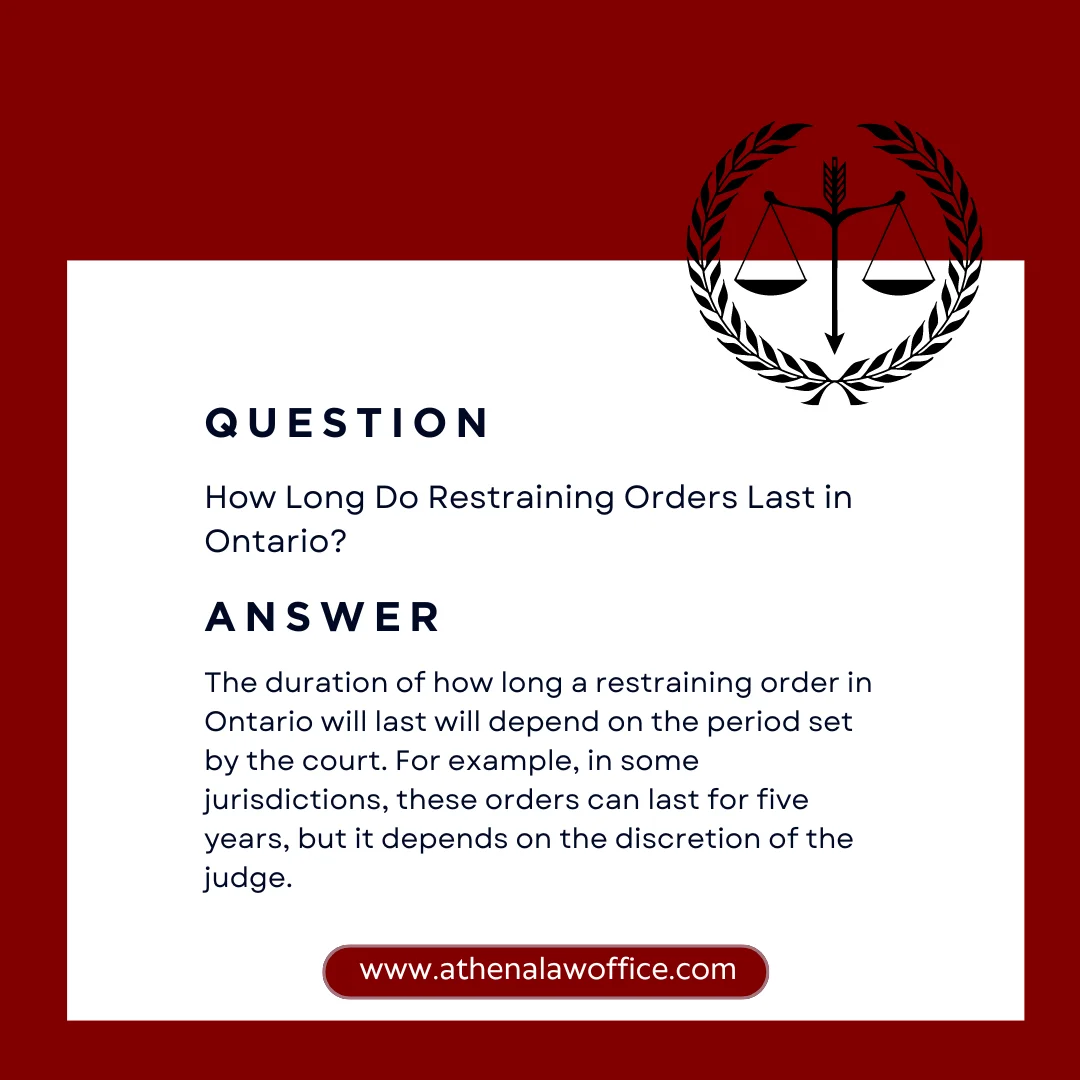
The duration of how long a restraining order in Ontario will last will depend on the period set by the court. For example, in some jurisdictions, these orders can last for five years, but it depends on the discretion of the judge.
So, it is up to the court to decide how long the order will last. During this time, it is important that both parties follow the terms of the order; otherwise, a violation could lead to serious consequences.
Breaching a Restraining Order: What is the Penalty?
If there is a breach of the restraining order, then you can immediately contact the police. Other than that, you can also arrange to go to a safe place, such as a loved one’s home or a women’s shelter.
Under Section 127 of the Criminal Code, it is a criminal offence to breach a restraining order. If the other party violates this order, they will be arrested and charged.
If they are convicted, they may have to face jail time or fines. If you think the police are not being helpful in enforcing the restraining order in Ontario, then you can get in touch with our family law experts.
No Contact Order vs Restraining Order
There are many orders you can apply for in the Ontario family court. It is crucial to understand the distinction between them to ensure you are making the right order.
Keep in mind that no-contact orders are related to criminal proceedings, unlike restraining orders, which are used in civil and family law. Restraining orders are specifically for harassment or domestic violence you may be facing from your family or spouse.
The Criminal Code highlights when no-contact conditions will be applicable during a bail or hearing.
Peace Bond vs Restraining Order
Please note that a peace bond is not the same as a restraining order. A peace bond is a court order to ensure you keep the peace and are on good behaviour for a specific period of time.
This means that you will not be charged with a criminal offence. However, peace bonds can have various conditions, such as staying away from someone or not having any weapons.
Another important point to note is that you can make an order for a peace bond against anyone. On the other hand, you can only apply for restraining orders against someone you live with or have children with.
FAQs
What is an ex parte restraining order in Ontario?
An ex-parte restraining order in Ontario is one where the judge gives the order without letting the abuser know. It is generally a temporary order to ensure the safety of the victim if being in the same place as the abuser is not safe anymore.
What proof do you need for a restraining order in Canada?
Pictures of injuries or damaged property, police reports, recorded conversations, witness testimony, and much more. Be sure to collect this evidence to make your case stronger for the restraining order in Ontario.
Is a restraining order the same as a peace bond in Ontario?
No. A restraining order can only be made against someone you have lived with or have had children with. However, a peace bond in Ontario can be made against anyone to restrict their behaviour.
Does a restraining order go on your record in Canada?
Whether a restraining order will go on your record in Canada will depend on the circumstances of your case and your background. However, the general rule of thumb is that civil restraining orders don’t show up on criminal records because they are not considered criminal offences.
Final Thoughts
Now that you know how to get a restraining order in Ontario against your ex-spouse, we recommend you take this step when necessary. It will protect your rights and ensure safety in the long run.
For guidance about this process, feel free to get in touch with our family lawyer. We provide expert legal advice that will help you get what you want out of the court order while protecting your safety.
Author Profile

- Barnett Law is a trusted and knowledgeable lawyer in Scarborough. Her expertise spans real estate law, family law, adoptions and fertility law. A lawyer by profession and a humanitarian by heart, Athena Narsingh Barnett wants to help people become more familiar with the legal system and be well-informed to make important legal decisions.
Latest entries
 legal guidanceJuly 4, 2025What Disqualifies You From Adopting A Child In Canada?
legal guidanceJuly 4, 2025What Disqualifies You From Adopting A Child In Canada? legal guidanceJune 30, 2025Is A Rooming House Legal In Ontario?
legal guidanceJune 30, 2025Is A Rooming House Legal In Ontario? legal guidanceJune 27, 2025Assisted Human Reproduction Act: Protecting Your Right To Build A Family
legal guidanceJune 27, 2025Assisted Human Reproduction Act: Protecting Your Right To Build A Family legal guidanceJune 23, 2025Fertility Law: Insights About Challenges And Legal Protection
legal guidanceJune 23, 2025Fertility Law: Insights About Challenges And Legal Protection


